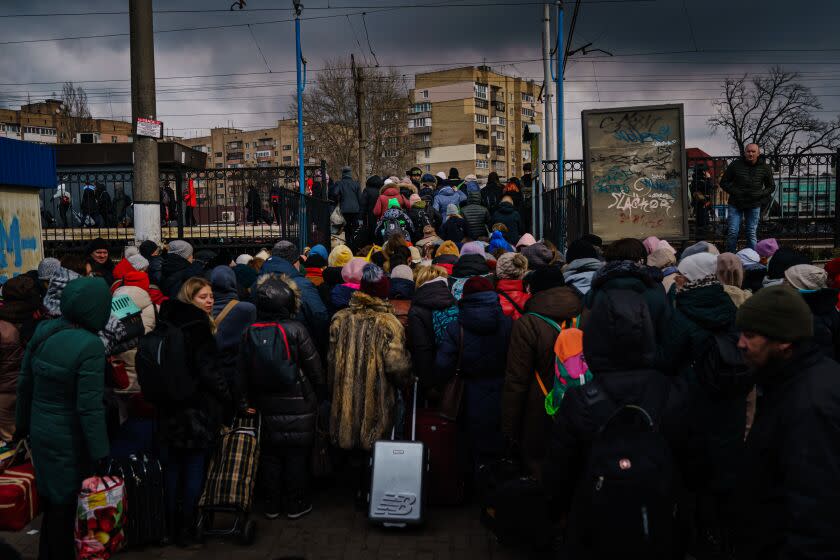Op-Ed: In Ukraine, as in other wars, the full history will take years to tell and it will be told by women

Stories of war — the ones we tell the loudest — are often about men. But for the true cost of war to be clear, we must do a better job of telling, and hearing, the stories of women — ordinarily civilians.
The stories of men — whether in movies, books or other media — are frequently stories of militarization. They present themselves with urgency, as breaking news. In my own research as a writer, the stories I regularly encounter about men are of moments: the moment a man left his family to fight, the moment he fired his first shot, the moment he was heroic or even the moment he committed a crime. The moment he died. Hearing such a tale may take only a moment too.
The stories of women, on the other hand, are often long. They require a more enduring attention from both tellers and listeners willing to comprehend the unspoken, the daily work of care and the long consequences of conflict. I learned this lesson as I shifted how I understood and wrote about the quarter-century-long civil war in Sri Lanka, where my parents grew up.
Of course, nowhere is the narrative of war and women currently clearer than in Ukraine. When Russia invaded in February, men 18 to 60 years of age were required to stay and fight, so women and children comprise the majority of Ukraine’s nearly 6 million refugees. (Women also make up more than 20% of Ukraine’s military.)
A recent U.N. report warned about the war’s gendered consequences, noting that even before the war, women-headed households in Ukraine were experiencing above-average levels of food insecurity. Now, the situation is likely even worse. Ukrainian women who live in Russian-occupied rural territories, for example, face both security concerns and scarce resources that make agricultural labor challenging.
Watching news about Ukraine hit home for me. In writing about the Sri Lankan civil war, which lasted from 1983 to 2009, I have focused my attention on the experiences of minority Tamil civilians, specifically women.
As a young reader, I was fascinated by stories of Tamil women in Sri Lanka joining the Tamil Tigers, the militant group fighting for a separate state for Tamil minorities in the north and east of the country following decades of discrimination by successive Sri Lankan governments. The Tigers’ feminism was evident, some proclaimed, given the determined, fatigue-clad women in their ranks. The seeming novelty of this image and narrative dominated the story of women in the war. But it became clear to me that the Tigers had also committed many atrocities, including massacring civilians and conscripting children.
As I began to understand how state and militant violence fed each other, I turned my attention to the civilians caught in between. Their stories required me to ask different questions, and to listen hard to see how the answers evolved. In interviews for my new novel, women spoke of carrying elders and children out of their houses as soldiers or militants encroached. Repeatedly displaced, they created homes over and over again.
These are stories not of moments, but of years. Because of the large number of disappearances during Sri Lanka’s war, some women do not know what happened to the men in their families. Many live in economic precarity, without the support networks they had in their original homes. One legacy of the fighting is an estimated 90,000 war widows and many female-headed households still mired in poverty.
Women withstanding war must find new places and ways to live, in worsening circumstances. Of course, in Ukraine as in Sri Lanka, war has meant the separation and alteration of families. Women in countries at war often become sole caregivers to children and the elderly; women teach children who cannot attend school. Many women in wartime are pregnant, as 265,000 Ukrainians were at the onset of the war. Women are the first to become vulnerable to sexual violence, which Russia is reportedly perpetrating in Ukraine. And as I found in my research, when it is necessary, women protest and attempt to hold those responsible to account during — and after — war.
Beyond all this, women become the repositories of memories of destroyed culture.
These stories took their time. To truly hear them, I had to become a better listener — better able to understand that sometimes I would need to wait for people to trust others with their stories. I had to see and value the ordinary, vital domestic labor that kept children, elders and displaced persons alive. And I had to be persistent, returning to the same questions to understand how long and with how many variations the war would take its toll on the most vulnerable.
In the years to come, as we contend with the long aftermath of conflict in Ukraine, Sri Lanka and elsewhere, I hope that we will become better at understanding and sharing the stories of civilian women during wartime. These stories are as necessary as those of men bearing arms, and it is only in listening to them that we can make plain war’s brutal, lasting price.
V.V. Ganeshananthan is author of the forthcoming novel “Brotherless Night” and co-host of the Literary Hub podcast “fiction/non/fiction.” She teaches creative writing at the University of Minnesota. @v_v_ganeshananthan
This story originally appeared in Los Angeles Times.

